-
You are viewing the forum as a Guest, please login (you can use your Facebook, Twitter, Google or Microsoft account to login) or register using this link: Log in or Sign Up
You are using an out of date browser. It may not display this or other websites correctly.
You should upgrade or use an alternative browser.
You should upgrade or use an alternative browser.
Black out and BBA
- Thread starter Tucker90
- Start date
Djoko Sauza
Member
I wouldn't be able to tell you if the blackout will work, I simply spot dose with liquid carbon if there's any BBA. But if you do go for it,
You can also spot dose with H2O2 Hydrogen Peroxide instead of liquid carbon.
Livestock will be just fine. Don't dose any ferts or co2 during the blackout and make sure the water is oxygenated (some surface movement is enough in most cases).And if so, will live stock survive? Or shall I re-locate?
You can also spot dose with H2O2 Hydrogen Peroxide instead of liquid carbon.
I wouldn't be able to tell you if the blackout will work, I simply spot dose with liquid carbon if there's any BBA. But if you do go for it,
Livestock will be just fine. Don't dose any ferts or co2 during the blackout and make sure the water is oxygenated (some surface movement is enough in most cases).
You can also spot dose with H2O2 Hydrogen Peroxide instead of liquid carbon.
Thanks for the reply!
The picture is a small example of a the algae, the tank is riddled with it! Soot dosing would take an 3L of excel

Sent from my iPhone using Tapatalk
Djoko Sauza
Member
Shamelessly stealing this idea from @KarmicnullI've been doing something similar in my low-tech to combat thread algae:
Part 1: gradually up my Glute (Excel) to 2x the recommended daily (non WC) dose. This I did with no ill effect. Seen increased growth in stems. Doesn't seem to have affected the epiphytes though. Livestock appear oblivious.
Part 2: Prior to weekly WC:
(a) Switch off / remove the filter, and dose 1ml per 3L of 3% H202 (I took my sponge filters out temporarily).
(b) Put a powerhead in for 15 mins to make sure the H202 is properly circulated everywhere.
(c) Do W/C.
(d) Put filter back in.
(e) Immediately do daily dose of glute (I saw this described as 'hit the algae when it's down').
I did this for two weeks in a row and the thread algea has gone. I'm now pausing on the H2O2 but carrying on with the glute, will wait and see if it comes back.
Cheers,
Simon
Note he used it to get rid of thread algae but this should work with BBA as well.
Another option would be to almost drain the tank and spray a 50/50 water and liquid carbon solution in the affected areas. When dosing large amounts of liquid carbon I'd recommend rehoming any livestock, that stuff is nasty.
Someone correct me if I'm wrong but I think a blackout really won't help you against BBA.
MichaelJ
Member
An alternative to pummel the tank with Glute/Carbo/Excel and possibly jeopardizing the livestock, you can try spot treating. I've tried it with varying degrees of success a couple of times way in the past. The best approach I've found, besides setting expectations fairly low, is to take the plant out of the tank, let it dry just a little bit and use a small paint brush to spot treat infected areas of the leaves that appears salvageable with a tiny amounts of Excel - be careful the Excel don't get on the roots! When done, let the Excel sit on the leaves for a minute or two and put the plant back into the tank. Leaves that are severely covered in algae will not recover and are better removed right away - keeping the severely infected leaves around, will only drag down the rest of the plant and delay recovery. The approach where you dip the whole plant (minus the roots) into a mixture of water and Excel and let it sit for a few minutes never worked for me - its possible the mixture was too strong when I tried it. BBA are almost impossible to remove mechanically... and will likely be back if light intensity vs. CO2 and maintenance are not up to par.
I do not know if blackout helps - never tried it - I guess without light everything will eventually die.
Cheers,
Michael
I do not know if blackout helps - never tried it - I guess without light everything will eventually die.
Cheers,
Michael
Last edited:
Hi,
I personally believe that the length of time needed to rid your tank of BBA using the Blackout Method will be far more detrimental to your plants than the BBA.
For me when I have dealt with it in the past, Spot Dosing EasyCarbo and meticulous Manual Removal of badly affected leaves worked best, if wanting to avoid Crypt Melt and having your Fauna swimming around in a toxic soup etc...
Making life easier was spraying a weak solution of EC on all affected areas with an atomiser, while the tank was empty ish during a 90% water change.
What ever method you use, it will be a labour of love.
Cheers!
I personally believe that the length of time needed to rid your tank of BBA using the Blackout Method will be far more detrimental to your plants than the BBA.
For me when I have dealt with it in the past, Spot Dosing EasyCarbo and meticulous Manual Removal of badly affected leaves worked best, if wanting to avoid Crypt Melt and having your Fauna swimming around in a toxic soup etc...
Making life easier was spraying a weak solution of EC on all affected areas with an atomiser, while the tank was empty ish during a 90% water change.
What ever method you use, it will be a labour of love.
Cheers!
Karmicnull
Member
Further to @Diogo Sousa's quote above I can add that the thread algae hadn't come back yet, so it worked for me.
Hi all,
If you get some Ramshorn Snails they should deal with it, but it <"will take a while"> because they don't eat the mature tufts.
cheers Darrel
I'd probably start with that and a filter clean.......... manual Removal of badly affected leaves
If you get some Ramshorn Snails they should deal with it, but it <"will take a while"> because they don't eat the mature tufts.
cheers Darrel
Thanks for all the advice.
Bit of an update, made a solution of excel and water,
Sprayed all the plants at a 90% water change.
Did another 50% water change the next day then went away for 2 days.
Unfortunately I have returned to a very very ugly tank.
Bolbitis, vals lotus and moss have all melted.
Lost a couple of shrimp as well.
The good news is the BBA has gone.
Maybe if this is done I should have done regular 50% water changes daily but would still have seen the plant melt
Sent from my iPhone using Tapatalk
Bit of an update, made a solution of excel and water,
Sprayed all the plants at a 90% water change.
Did another 50% water change the next day then went away for 2 days.
Unfortunately I have returned to a very very ugly tank.
Bolbitis, vals lotus and moss have all melted.
Lost a couple of shrimp as well.
The good news is the BBA has gone.
Maybe if this is done I should have done regular 50% water changes daily but would still have seen the plant melt
Sent from my iPhone using Tapatalk
Tom Raffield
Member
Thread hijack! 😀 I have a similar problem to the OP. I set up a new low tech, low maintenance tank (260l) last year and have a Fluval FX4 plus DIY spray bar and run JBL LED Solar and Natur lighting for about 9 hours a day. I dose liquid ferts (macro and micro) very infrequently. There is a pressurised CO2 system attached to the tank which I am still using at a rate of 2/3 bubbles per second and have done this whole year as I wait for the cylinder to finish. This was a thread about the build (Tank Rebuild)
Due to having a second baby daughter and a two year old were my main reasons for my tank rebuild and for the whole of the first year, all appears to have been well. My maintenance routine is very limited involving topping up water rather than water changes; I also remove old or decaying leaves from plants and hand trim the roots from the amazon frogbit. There is no space to clean the substrate in anyway so I leave that alone. Feeding for the fish is once every three days or so.
The BBA has really started taking off in the last week so I did a 70% water change and cleaned the filter. This at first glance has made it worse possibly due to the CO2 fluctuation. I also think the amazon frogbit might actually be having a negative impact on the tank. Yes it is shadowing the tank from high lighting but the roots reach down 75% of the side of tank within a week which must be having an impact on water circulation. I do trim the roots right back to about 5cm every week and remove any of the older or damaged frogbit. Other things to note is that some of the leaves on the hygrophila are now showing quite strong veining - is this a deficiency and if so, of what? I also had to angle the spray bar more downward as the output was running straight into the frogbit roots.
Is there anything else I can do? Should I go for a shock treatment of Excel? Or do I have to consider a much heavier maintenance schedule moving forward? Do I need to head back to EI dosing of ferts and getting back on the CO2? In an ideal world I want the easiest tank possible; that said I am willing to put some maintenance time into the tank but can not go back to the hours and hours I used to do with a previous scape. At the end of the day though, and in the immediate term, I really don't want this BBA taking over and ruining my tank. Any and all advice welcomed!
Due to having a second baby daughter and a two year old were my main reasons for my tank rebuild and for the whole of the first year, all appears to have been well. My maintenance routine is very limited involving topping up water rather than water changes; I also remove old or decaying leaves from plants and hand trim the roots from the amazon frogbit. There is no space to clean the substrate in anyway so I leave that alone. Feeding for the fish is once every three days or so.
The BBA has really started taking off in the last week so I did a 70% water change and cleaned the filter. This at first glance has made it worse possibly due to the CO2 fluctuation. I also think the amazon frogbit might actually be having a negative impact on the tank. Yes it is shadowing the tank from high lighting but the roots reach down 75% of the side of tank within a week which must be having an impact on water circulation. I do trim the roots right back to about 5cm every week and remove any of the older or damaged frogbit. Other things to note is that some of the leaves on the hygrophila are now showing quite strong veining - is this a deficiency and if so, of what? I also had to angle the spray bar more downward as the output was running straight into the frogbit roots.
Is there anything else I can do? Should I go for a shock treatment of Excel? Or do I have to consider a much heavier maintenance schedule moving forward? Do I need to head back to EI dosing of ferts and getting back on the CO2? In an ideal world I want the easiest tank possible; that said I am willing to put some maintenance time into the tank but can not go back to the hours and hours I used to do with a previous scape. At the end of the day though, and in the immediate term, I really don't want this BBA taking over and ruining my tank. Any and all advice welcomed!
Last edited:
Tom Raffield
Member
Photos taken just now. As you can see. The BBA is making a fairly good go at touching all the plants in one or another which would make spot treating somewhat tricky. I'm hoping I can salvage this before its too late!
Note on the inhabitants: I have amano shrimp and nerite snails in the tank. The fish are a fairly hardy bunch.
Note on the inhabitants: I have amano shrimp and nerite snails in the tank. The fish are a fairly hardy bunch.
Attachments
-
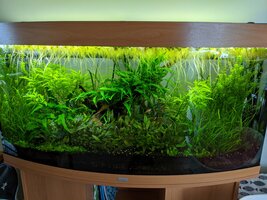 PXL_20211025_121928124.jpg3.3 MB · Views: 252
PXL_20211025_121928124.jpg3.3 MB · Views: 252 -
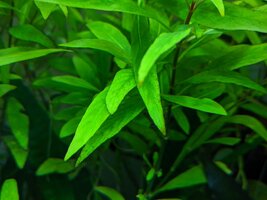 PXL_20211025_121943483.jpg1.5 MB · Views: 259
PXL_20211025_121943483.jpg1.5 MB · Views: 259 -
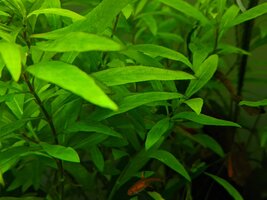 PXL_20211025_121953844.jpg1.7 MB · Views: 256
PXL_20211025_121953844.jpg1.7 MB · Views: 256 -
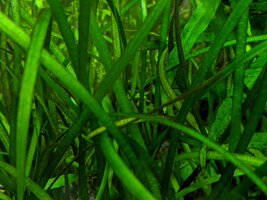 PXL_20211025_122027363.jpg2 MB · Views: 268
PXL_20211025_122027363.jpg2 MB · Views: 268 -
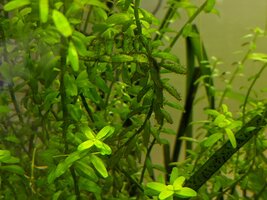 PXL_20211025_122043765.jpg2 MB · Views: 253
PXL_20211025_122043765.jpg2 MB · Views: 253 -
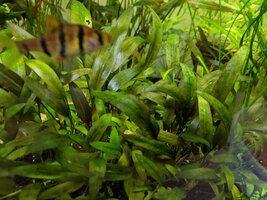 PXL_20211025_122224116.jpg3.4 MB · Views: 262
PXL_20211025_122224116.jpg3.4 MB · Views: 262 -
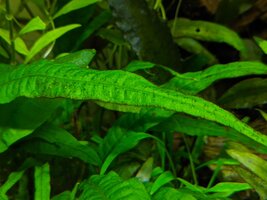 PXL_20211025_122237450.jpg1.7 MB · Views: 230
PXL_20211025_122237450.jpg1.7 MB · Views: 230 -
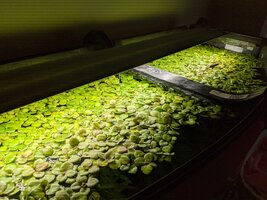 PXL_20211025_122106536.jpg3.7 MB · Views: 253
PXL_20211025_122106536.jpg3.7 MB · Views: 253
Last edited:
Your algae appears to be staghorn, not BBA @Tom Raffield
Usually associated with the buildup of organic waste and crud. Cleaning the filter a bit will likely have helped, maybe increasing the frequency of filter maintenance is a good move. You could also remove some more of the oldest plant leaves and generally do some tidying on the bottom of the tank. Sometimes you can suck up some mulm without having to disturb the substrate much, you would be surprised how much can build up in nooks and crannies.
Unless you are adding Mg seperately in some way, odds are your plants could use some more of this on a regular basis. Normally chasing down individual deficiencies is a bit of a wild goose chase, missing the overall bigger picture. But Mg is one of those which are easier to identify and makes a slightly bigger difference in my opinion.
I dont think this is the sole cause of the algae, but it is something that can contribute to healthier robust plants.
You can start with just some Magnesium on a regular basis and see how the plants respond. Since your tank seems to be going steadily it is possible that the macros and micros you are adding (although infrequently), is enough to keep the plants going.
What is your TDS currently at? I would monitor this value, aiming to feed the plants a bit more without causing large increases in TDS.
The TDS tells us how much "stuff" we have in the water, but not precisely what the "stuff" consists of.
If youre not changing much water I would want to avoid feeding the plants much more than they can eat, so you definitely dont have to go full EI.
A little is a lot better than nothing for the plants.
Edit: If you could squeeze in a few more water changes I think that would be good against the staghorn.
Other than this I think plant health overall looks very nice
Usually associated with the buildup of organic waste and crud. Cleaning the filter a bit will likely have helped, maybe increasing the frequency of filter maintenance is a good move. You could also remove some more of the oldest plant leaves and generally do some tidying on the bottom of the tank. Sometimes you can suck up some mulm without having to disturb the substrate much, you would be surprised how much can build up in nooks and crannies.
Some of the leaves appear to be deficient in Magnesium, which makes sense when you say fertilization is infrequent and you dont change much of the water.Other things to note is that some of the leaves on the hygrophila are now showing quite strong veining - is this a deficiency and if so, of what?
Unless you are adding Mg seperately in some way, odds are your plants could use some more of this on a regular basis. Normally chasing down individual deficiencies is a bit of a wild goose chase, missing the overall bigger picture. But Mg is one of those which are easier to identify and makes a slightly bigger difference in my opinion.
I dont think this is the sole cause of the algae, but it is something that can contribute to healthier robust plants.
You can start with just some Magnesium on a regular basis and see how the plants respond. Since your tank seems to be going steadily it is possible that the macros and micros you are adding (although infrequently), is enough to keep the plants going.
What is your TDS currently at? I would monitor this value, aiming to feed the plants a bit more without causing large increases in TDS.
The TDS tells us how much "stuff" we have in the water, but not precisely what the "stuff" consists of.
If youre not changing much water I would want to avoid feeding the plants much more than they can eat, so you definitely dont have to go full EI.
A little is a lot better than nothing for the plants.
Edit: If you could squeeze in a few more water changes I think that would be good against the staghorn.
Other than this I think plant health overall looks very nice
Last edited:
Tom Raffield
Member
Thanks for the advice @Hufsa. I'll do some plant maintenance tomorrow and try and vacuum any substrate that I can get to. Will also build in another very large water change. Depending how brave I feel, I might make a mix of water and Excel to spray the plants when they are exposed during the water change.
My dosing is exceptionally minimal as I was going for low tech but I guess the plants will still need nutrients. I'll up the frequency of dosing my micros and macros (which has a lot of magnesium anyway) or would it be best to make a separate solution just for the magnesium and see how we go. Could the frogbit root length be a nutrient deficiency too? They used to reach an inch or two in length at the beginning but now can get up to 20-30cm which totally destroys any flow my spray bar creates.
As for TDS, I don't measure this and don't have the equipment to do so. Is this something that I should be investing in?
My dosing is exceptionally minimal as I was going for low tech but I guess the plants will still need nutrients. I'll up the frequency of dosing my micros and macros (which has a lot of magnesium anyway) or would it be best to make a separate solution just for the magnesium and see how we go. Could the frogbit root length be a nutrient deficiency too? They used to reach an inch or two in length at the beginning but now can get up to 20-30cm which totally destroys any flow my spray bar creates.
As for TDS, I don't measure this and don't have the equipment to do so. Is this something that I should be investing in?
I would be careful with the Excel, if overzealous you could melt the plants giving yourself a much bigger problem. I am not a big fan of Excel though. I think going for the cause will be a better fix and then the plants will do the rest of the work for you.
The frogbit could be sending out longer roots because the water is lower on nutrients. But based on the amount of fairly healthy plantmass you have, including quite a lot of the frogbit, I would be reluctant to conclude that there are -no- nutrients. I think that for tanks that dont get a large amount of water changes, phosphate will build up the most as is it plentiful in fish food, with nitrate coming in second. Often other nutrients like potassium and the somewhat flighty iron will be in short supply in relation to them. Same with Magnesium, if your tap water contains any, it is very likely in much lesser quantity than Calcium, and the plants can quickly exhaust their supply of it.
Keeping that in mind I would personally try to add just the ones that are likely to be missing first, in a more targeted fertilizer. Even though you dont regularly "fertilize", you are still adding some fertilizer in the form of fish food, on a regular basis. Hence the steadier supply of phosphate and nitrate.
I would get a TDS pen, they are pretty cheap and in my opinion more useful than some of the test kits. It would be useful for you to be able to monitor build up in your tank, and get a better read on how much of anything is present.
The frogbit could be sending out longer roots because the water is lower on nutrients. But based on the amount of fairly healthy plantmass you have, including quite a lot of the frogbit, I would be reluctant to conclude that there are -no- nutrients. I think that for tanks that dont get a large amount of water changes, phosphate will build up the most as is it plentiful in fish food, with nitrate coming in second. Often other nutrients like potassium and the somewhat flighty iron will be in short supply in relation to them. Same with Magnesium, if your tap water contains any, it is very likely in much lesser quantity than Calcium, and the plants can quickly exhaust their supply of it.
Keeping that in mind I would personally try to add just the ones that are likely to be missing first, in a more targeted fertilizer. Even though you dont regularly "fertilize", you are still adding some fertilizer in the form of fish food, on a regular basis. Hence the steadier supply of phosphate and nitrate.
I would get a TDS pen, they are pretty cheap and in my opinion more useful than some of the test kits. It would be useful for you to be able to monitor build up in your tank, and get a better read on how much of anything is present.
Tom Raffield
Member
Thanks @Hufsa, I decided against using an Excel at this stage but I did do a mini vac of the substrate (where I could get to) but this was a very limited area. Guess it is better than nothing. Also did a 30% water change as part of this.
I have only ever used micro and macro mixes from APF, would you recommend a brand for the specific fertilisers I need?
The frogbit did start as a small patch but it has gone mad and I actually quite like it as it shades the tank from the LED lighting. From what I have read, higher nitrate levels could be the cause of the longer roots and perhaps the other plants are now starting to suffer from nutrient deficiency due to the amount of frogbit absorbing the nutrients from the water column.
The long roots / high nitrates would fit with the very limited top-up water changes I have done over the last year. So perhaps rather than trimming these roots weekly, I need to reintroduce a decent sized water change every now and again. Not weekly as this is something I have wanted to move away from but perhaps every two weeks or so and also feed the fish very sparingly.
I'll have a look for a TDS pen online. I am sure they can be found easily enough and then I can let you know the reading and we can see what is really going on.
I have only ever used micro and macro mixes from APF, would you recommend a brand for the specific fertilisers I need?
The frogbit did start as a small patch but it has gone mad and I actually quite like it as it shades the tank from the LED lighting. From what I have read, higher nitrate levels could be the cause of the longer roots and perhaps the other plants are now starting to suffer from nutrient deficiency due to the amount of frogbit absorbing the nutrients from the water column.
The long roots / high nitrates would fit with the very limited top-up water changes I have done over the last year. So perhaps rather than trimming these roots weekly, I need to reintroduce a decent sized water change every now and again. Not weekly as this is something I have wanted to move away from but perhaps every two weeks or so and also feed the fish very sparingly.
I'll have a look for a TDS pen online. I am sure they can be found easily enough and then I can let you know the reading and we can see what is really going on.
Last edited:
I mix my own ferts with powders so I cant advise on any brands, sorry. APF sells Magnesium sulfate and Potassium Sulfate, so you could get those from there. Either make up a solution for them or sprinkle some in, whatever you are comfortable with. You can find out the amount for your tank through the calculators, either IFC from the forum here or Rotala butterfly
Matti
Member
For me the only thing that really has worked is to soak infected plants in bleach, that kills BBA in 30s. Household bleach and water in 1/3.
And after bleach soak them in water+aquasafe or any other water conditioner to remove the chloride!
Exel and similar EasyCarbo has also worked, but I've found it's can be bad stuff for some plants and I stopped using it.
And after bleach soak them in water+aquasafe or any other water conditioner to remove the chloride!
Exel and similar EasyCarbo has also worked, but I've found it's can be bad stuff for some plants and I stopped using it.
Thanks for all the responses,
After the major melt things have started to grow back.
The BBA persisted so took drastic steps.
All the wood and Every plant was pulled and I made a solution of water and household bleach 4/1
Scrubbed the wood with a brush and Soaked for 5 mins and then rinsed with prime.
I then gave the oase a bloody good going over, and did a 90% water change.
One thing I did notice is there was a huge amount of organic matter built up in spots within the plants.
I took the opportunity to re-arrange the tank to give a bigger “beach” area as I fancy some corys.
It’s still not finished as it’s hard to do with livestock remaining in the tank, but I’ve got a plant order waiting for payday and will be re-scaping next month.
Since doing all this I haven’t got any BBA in the tank and have seen a massive increase in growth from all plants.
So, better maintenance on the filter and clearing organic build ups seems to be the way to go!
Sent from my iPhone using Tapatalk
After the major melt things have started to grow back.
The BBA persisted so took drastic steps.
All the wood and Every plant was pulled and I made a solution of water and household bleach 4/1
Scrubbed the wood with a brush and Soaked for 5 mins and then rinsed with prime.
I then gave the oase a bloody good going over, and did a 90% water change.
One thing I did notice is there was a huge amount of organic matter built up in spots within the plants.
I took the opportunity to re-arrange the tank to give a bigger “beach” area as I fancy some corys.
It’s still not finished as it’s hard to do with livestock remaining in the tank, but I’ve got a plant order waiting for payday and will be re-scaping next month.
Since doing all this I haven’t got any BBA in the tank and have seen a massive increase in growth from all plants.
So, better maintenance on the filter and clearing organic build ups seems to be the way to go!
Sent from my iPhone using Tapatalk



